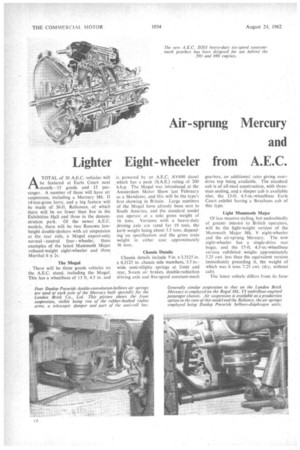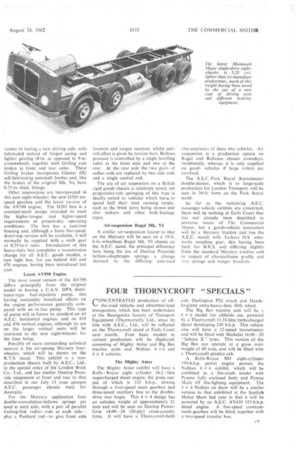Air-sprung Mercury and Lighter Eight-wheeler from A.E.C.
Page 34

Page 37

If you've noticed an error in this article please click here to report it so we can fix it.
ATOTAL of 30 A.E.C. vehicles will be featured at Earls Court next month-15 goods and 15 passenger. A number of these will have air suspension, including a Mercury Mk. II 14-ton-gross lorry, and a big feature will be made of 36-ft. Reliances, of which there will be no fewer than five in the Exhibition Hall and three in the demonstration park. Of the newer A.E.C. models, there will be two Renown. lowheight double-deckers with air suspension at the rear axle, a Mogul export-only normal control four wheeler, three examples of the latest Mammoth Major reduced-weight eight-wheeler and three Marshal 6 x 2s.
The Mogul There will be three goods vehicles on the A.E.C. stand, including the Mogul. This has a wheelbase of 13 ft, 4.5 in. and is powered by an A.E.C. AV690 diesel which has a peak (S.A.E.) rating of 200 b.h.p. The Mogul was introduced at the Amsterdam Motor Show last February as a Mandator, and this will be the type's first showing in Britain. Large numbers of the Mogul have already been sent to South America. and the standard model cars operate at a solo gross weight of 16 tons. Versions with a heavy-duty driving axle are rated for 19 tons, the kerb weight being about 5.5 tons, depending on specification and the gross train weight in either case approximately 36 tons.
Chassis Details Chassis details include 9 in. x 3.3125 in. x 0.3125 in. chassis side members, 3.5 in.wide semi-elliptic springs at front and rear, S-cam air brakes, double-reduction driving axle and five-speed constant-mesh gearbox, an additional ratio giving overdrive top being available. The standard cab is of all-steel construction, with threeman seating, and a sleeper cab is available also, the 13-ft: 4.5-in.-wheelbase Earls Court exhibit having a Strachans cab of this type.
Light Mammoth Major Of less massive styling, but undoubtedly of greater interest to British operators, will be the light-weight version of the Mammoth Major Mk. V eight-wheeler and the air-sprung Mercury. The new eight-wheeler has a single-drive rear bogie, and the 17-ft. 4.5-in.-wheelbase version exhibited weighs approximately 5.25 cwt. less than the equivalent version immediately preceding it, the weight of which was 6 tons 7.25 cwt. (dry, without cab).
The latest vehicle differs from its fore runner in having a new driving axle. with fabricated instead of forged casing and lighter gearing (8-in, as opposed to 9-in. crownwheel), together with Girling cam brakes at front and rear axles. These Girling brakes incorporate Glacier DU self-lubricating camshaft bushes and, like the brakes of the original Mk. Vs, have 0.75-in.-thick linings.
Other innovations are incorporated in this new eight-wheeler; the new D203 sixspeed gearbox and the latest version of the AV590 engine. The D203 box is a constant-mesh design intended to meet the higher-torque and higher-speed requirements of present-day operating conditions. The box has a cast-iron housing and, although a basic five-speed, direct-top version will be available, it will normally be supplied with a sixth gear of 0.`75-to-1 ratio. Introduction of this heavy-duty box completes a transmission change for all A.E.C. goods models, a new light box, for use behind 410 and 470 engines, having been intrbduced last year.
Latest AV590 Engine
The most recent version of the AV590 differs principally from the original model in having a C.A.V. DPA distributor-type fuel-injection pump, this having noticeably beneficial effects on the engine performance generally compared with an in-line pump. This type of pump will in future he standard on all A.E.C. horizontal engines, and on 410 and 470 vertical engines, although its use on the larger vertical units will be restricted to the new eight-wheeler for the time being.
Possibly of more outstanding technical interest is the air-sprung Mercury four: wheeler, which will be shOwn on the R.T.S. stand: This exhibit is a nonproduction chassis -built by A.E.C., Ltd., to the special order of the London Brick Co., Ltd., and has similar Dunlop.Pneuride suspension at front and rear to that described in our July 13 issue apropos A.E.C. passenger chassis built for Australia.
For the Mercury application four double-convolution-bellows springs are used at each axle, with a pair of parallel trailing-link radius rods at each side— plus a Panhard, rod—to give front axle
location and torque reaction, whilst antiroll effect is given hy torsion bars. Bellows pressure is controlled by a single levelling valve at the front axle and two at the rear. At the rear axle the two pairs of radius rods are replaced by two side rods and a single central .rod.
The use of air suspension on a British rigid goods chassis is relatively novel, yet progressive-rate springing of this type is ideally suited to vehicles which have, to spend half their time running empty, such as the brick lorry being shown and also tankers and other bulk-haulage types.
Air-suspension Regal Mk. VI A similar air-suspension layout to that on the Mercury will be seen on a 19-ft. 6-in.-wheelbase Regal Mk, VI chassis on the A.E.C. stand, the principal difference here being the use of Dunlop Pneuride bellows-diaphragm springs, a change dictated by the differing axle-load
characteristics of these two vehicles. Air suspension is a production option on Regal and Reliance chassis nowadays, incidentally, whereas it is only supplied on goods vehicles if large orders are involved.
The A.E.C.-Park Royal Routemaster double-decker, which is in large-scale production for London Transport, will be seen in 30-ft. form on the Park Royal stand,
So far as the remaining A.E.C. passenger-vehicle exhibits are concerned, there will be nothing at Earls Court that has not already been described in previous issues of The Commercial Motor, but a goods-vehicle innovation will be a Mercury tractive unit (on the A.E.C. stand) with Taskers D.S. automatic coupling gear. this having been built for B.R.S. and differing slightly from the standard Mercury tractive unit in respect of chassis-frame profile and rear springs and hanger brackets.








































































































